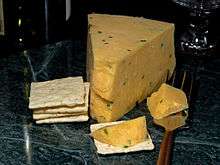Gloucester cheese
| Gloucester | |
|---|---|
 | |
| Country of origin | England |
| Region, town | Gloucestershire |
| Source of milk | Traditionally from Gloucester cattle |
| Pasteurised | No |
| Texture | semi-hard |
| Aging time | 36 weeks |
| Certification | Single Gloucester: PDO |
|
| |
Gloucester is a traditional, semi-hard cheese which has been made in Gloucestershire, England, since the 16th century, at one time made only with the milk of the once nearly extinct Gloucester cattle.
There are two types of Gloucester cheese: Single and Double; both are traditionally made from milk from Gloucestershire breed cows farmed within the English county of Gloucestershire.
Both types have a natural rind (outer layer) and a hard texture, but Single Gloucester is more crumbly, lighter in texture and lower in fat. Double Gloucester is allowed to age for longer periods than Single, and it has a stronger and more savoury flavour. It is also slightly firmer. The flower known as Lady’s Bedstraw (Galium verum), was responsible for the distinctively yellow colour of Double Gloucester Cheese. In the United Kingdom today, of these two types of cheese, it is the "Double Gloucester" which is more likely to be sold in supermarkets. Both types are produced in round shapes, but Double Gloucester rounds are larger. Traditionally whereas the Double Gloucester was a prized cheese comparable in quality to the best Cheddar or Cheshire, and was exported out of the County, Single Gloucester tended to be consumed within Gloucestershire.[1]
Most Double Gloucester sold in UK supermarkets is slab cheese, made in large creameries operated by major dairy companies such as Dairy Crest. It is normally sold as a supermarket own brand. This version of the cheese is pasteurised but not processed.
Variations

Double Gloucester is often blended with other ingredients. One variety made by blending with chives and spring onions has been marketed as Cotswold cheese, though this is not a traditional English cheese name.[2][3] This cheese is supposedly coloured similarly to Cotswold stone.[4]
Huntsman cheese, also known as Stilchester, is made with alternating layers of Double Gloucester and Stilton.
Origin of double and single names
The reason is not known for the two types of Gloucester cheese being called 'double' and 'single'. The main theories are:
- because the creamy milk had to be skimmed twice to make the double variety, or
- because cream from the morning milk was added to the evening milk, or
- because a Double Gloucester cheese is typically twice the height.[5]
Cheese Rolling
Double Gloucester cheese is also used every spring for the Cooper's Hill Cheese-Rolling and Wake, a sport considered to be dangerous due to the lengthy, steep Gloucestershire hillside[6] (50% downhill gradient at over 200 yards) in which the event takes place.
References
- ↑ "Double Gloucester". British Cheese Board. Retrieved 13 October 2009.
- ↑ Jones, David E. H. (1978-12-07). "Ariadne". New Scientist 80 (1132): 824. ISSN 0262-4079.
For cheese manufacturers, from some dying pressure of conscience perhaps, have taken to adding substances to cheese to give some counterfeit of flavour. For example, we now have Cotswold, a cheese with chives in it.
- ↑ Widcombe, Richard (1978), The Cheese Book, p. 57, ISBN 9780890096628,
Background: This is one of several new varieties of English cheese flavoured with various additives. Description: Cotswold is a version of the traditional English cheese Double Gloucester with chives added. It has the smooth, mellow taste of the typical Gloucester with the chives imparting a fragrant, delicate, oniony flavour.
- ↑ "Cotswold Cheese". Gourmet-food.com. Retrieved 6 July 2013.
- ↑ "British Cheese Board web-site". Retrieved 20 May 2012.
- ↑ "The Official Site of Cheese Rolling". Cheese-rolling.co.uk. Retrieved 6 July 2013.
| ||||||||||||||||||||||||||